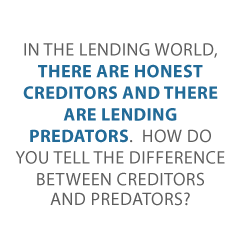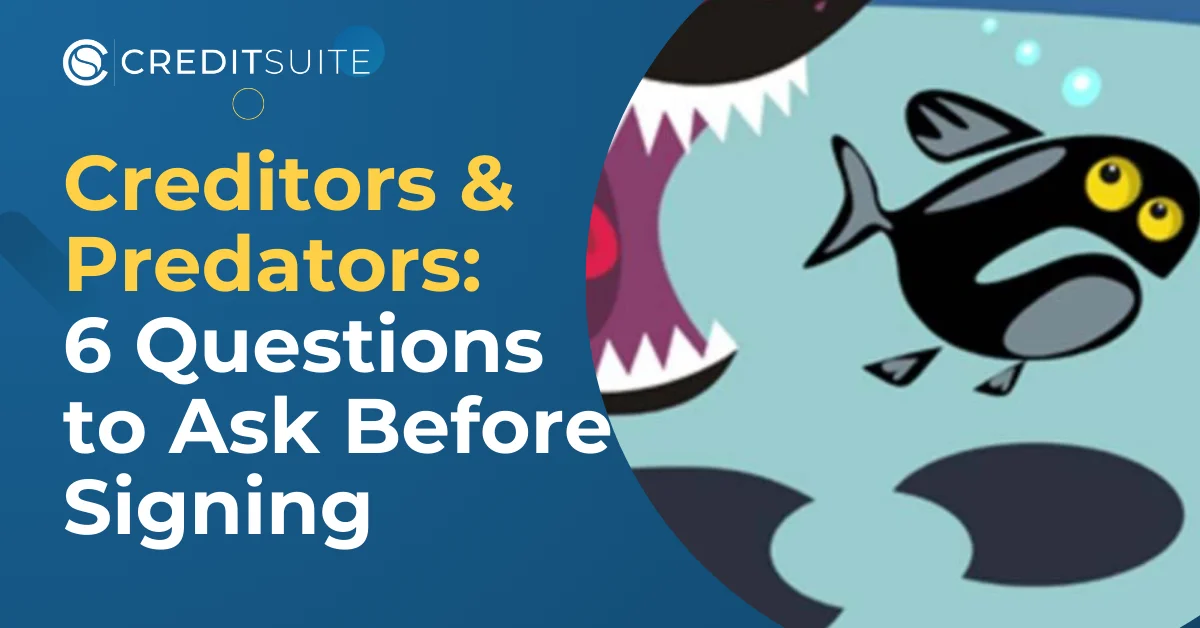In the lending world, there are honest creditors and there are lending predators. How do you tell the difference between creditors and predators? Is it possible to know whether or not you are working with someone reputable?
How to Tell the Difference Between Legit Creditors and Predators Out to Eat You Alive
Watch any animal reality show and you will see what happens between predators and prey. In a similarly menacing way, some lenders actually prey on unsuspecting borrowers. Not only do they leave finances in ruins, but often the trail of destruction trails across their entire lives. They basically eat their prey alive. How can you avoid falling victim to these devilish creatures?
We are going to show you how to tell the difference between legit creditors and predators, so that you can survive in the credit wilderness.
Know Thy Enemy: What is Predatory Lending
According to Investopedia: “Predatory lending benefits the lender and ignores or hinders the borrower’s ability to repay a debt. These lending tactics often try to take advantage of a borrower’s lack of understanding concerning loans, terms, or financial literacy.”
Basically, just like predators in the wild, predatory lenders take advantage of the weak. They look for those that are unassuming, easily tricked into coming closer, and without suitable defenses. Then they pounce.
In the wild, predators often disguise themselves as something else. Consider the Venus fly trap. To the fly, it looks like a flower. The fly saunters over to enjoy the beauty, and snap! It’s gone before it even knows what hit it. That is the peril of a predatory lender. It looks great, inviting even. Before you know it, however, they trap you.
The best protection you can have is to know the difference between creditors and predators. Don’t be fooled. Learn the signs and build your defenses. Know thy enemy.
Common Signs that a Creditor is Actually a Predatory Lender
The only way to tell the difference between creditors and predators is to know the signs of a predator. They are not that hard to spot if you know what tricks to look for.
Payment is King
If you are trying to get a loan and the “creditor” continues to emphasize what your payment will be, while downplaying how much the actual loan is, that creditor might be a predator. While a monthly payment is obviously important for budgeting purposes, you need to know all the terms of the loan.
A lender can use many tactics to ensure your monthly payment is where you need it to be to fit your budget. They can increase the loan period, adjust terms, and add balloons to make things look much better than they really are. The result is that you get a really bad loan in exchange for a temporary lower payment.
Burst the Balloon
Speaking of balloon loans, those are also a common predatory lending practice. They use them to provide unsuspecting borrowers with a low monthly payment for most of the loan. Most borrowers do not realize that they are typically only covering the interest for each month.
In fact, usually the principle isn’t reduced at all by payments until the very end of the loan. The final payment ends up being a large “balloon” payment that should pay off the entire principal of the loan all at once. Most of the time borrowers are not prepared for this, and they end up either refinancing or defaulting.
Unpack the Packing: Unnecessary Baggage
Packing is another practice that predatory lenders seem to lean towards. It involves them adding extras onto the loan. You do not need these extras, and they add them without your knowledge. The most common culprits are insurance products that are not necessary for your situation. You pay for them without realizing it, and they offer you no benefit.
Excessive Points and Fees
It’s not uncommon for lenders to charge points and fees on a loan. It is a practice that some use to increase profits. As a general rule, one point is worth one percent of the loan balance.
Asking for more points and higher fees than is normal for the type of loan you are getting can be a sign of predatory lending. If you feel that is what is going on, dig deeper.
How do you know what is “normal” and what is excessive? As a general rule, three points, or 3% of the loan amount or less, is a decent deal. This includes appraisals and title insurance, which are necessary. Research to see what is normal for your area, but know this is a good rule of thumb.
The New York Connection: Of Creditors and Predators and Judgements and Confessions
New York plays a unique role in the predatory lending drama. Knowing this can provide a pivotal clue when trying to determine if you are about to become prey. In New York, state law is friendly to confessions of judgement. Cash -advance companies, which are a huge faction of the predatory lending family, almost always make borrowers sign one of these as a loan condition.
If a borrower signs a confession of judgment, they are basically agreeing to lose in a court battle if a dispute arises about repayment. Regardless of where these types of loans take place, almost all of them contain a New York confession of judgement. If you see one of these in your loan documents, run.
Punishment for Paying Early
If they are going to charge a prepayment penalty, you should be wary. Early payment is a good thing, even though the lender loses some interest. It isn’t a deal breaker, but it should definitely cause you to look for other red flags and proceed with caution.
Obviously Seeking the Weak
Senior citizens, those with no credit or bad credit, minorities, those considered low income are all easy targets. They are more likely that others to get tangled up with predatory lenders, according to a 2015 Center for Responsible Lending report. Stay away from lenders that advertise in a way that targets these populations.
Language such as “bad credit doesn’t matter” is a definite sign. In addition, lenders that initiate contact unprovoked and those that try to rush your decision are bad news.
It’s a Bad Deal Now, but They’ll Fix It
Lenders that are searching for prey may try to get borrowers to sign on to a bad deal by promising to make it better in a future refinance. Do not fall for this. A bad deal is a bad deal. Just walk away.
Loan “Flipping” is NOT the Same a House “Flipping”
Flipping a house in real estate terms can actually be very profitable. However, loan flipping is something else altogether, and predatory lenders are great at it. When they see you struggling, they offer a refinance. While it may lower your payments, you end up paying points and fees again. Eventually you end up owing more than ever on your house, car, or whatever it is you used as collateral.
It is a vicious cycle that can bury you quickly.
The Payment Isn’t “All In”
This is typically and issue with predatory lending in mortgages. Inquire from the beginning as to whether there will be an escrow account set up for your required tax and insurance payments. Lenders that are not on the up and up will often make payments look super low because they do not include all the costs a borrower is responsible for.
What Are Some Questions I Can Ask to Help Discern Between Good Creditors and Predators?
Protecting yourself means recognizing these signs, they will not always be obvious. Sometimes you need to look a little closer. Asking these questions, whether to yourself or to the lender, can help you get to the root of the issue.
- Is the offer too good to be true?
As with almost anything in life, if it seems too good to be true, it probably is.
- What does the product truly cost?
If the lender doesn’t spell it out for you, do the math yourself. If you need help understanding it all, find someone you trust that can walk you through it. You need to know exactly what this loan is going to cost you. That means all fees, points, insurance, and taxes need to be clear before you can make an educated decision.
- Does the lender check my ability to repay?
It is ridiculous to think you will get a loan without the lender ensuring you can repay. It doesn’t have be a credit check. If they do not at least verify income or employment however, there is almost certainly a problem.
- Does the lender help me build credit?
Not all lenders do this, but if they do help you build your credit score, it is a point in their favor.
- Does the lender require electronic payments?
While there is nothing wrong with paying electronically, the requirement that electronic payments are the only way you can pay should throw up a red flag.
- Have others complained about the lender?
Check out reviews online. Look them up on the Better Business Bureau’s website at BBB.org. Find out if others have had a good experience with the lender, or not.
Is Anyone Doing Anything to Separate Creditors and Predators?
In recent years there has be a push by legislators to put an end to predatory lending practices. There have been safety nets in place for far longer however. What is being done? Does anyone care? Actually, yes, they do.
The Truth in Lending Act
It really started way before now with the Truth in Lending Act of 1968. This Act requires that lenders clearly communicate the sum of all payments, APR, and amount to be paid in interest and fees. In addition, the total credit that is being extended must be made clear. All of this has to be disclosed before a loan contract is signed.
Another component of the Truth in Lending Act is that a borrower has the right of rescission. This means that with certain loans, borrowers have three days to cancel after signing.
The Consumer Financial Protection Bureau
After the Dodd-Frank Wall Street Reform and Consumer Protection Act of 2010, the Consumer Financial Protection Bureau was born. The goal of the CFPB is to help oversee federal laws that protect consumers financially. They have resources that can help borrowers learn to decipher loan terms and risks, and also help them report and resolve any complaints they may have against lenders.
Signs of a Good Lender
Telling the difference between good creditors and predators means more than just knowing how to spot the bad guys. There are things to look for that can clue you in as to whether a lender is actually good, or if they are just not a predator. There is a gray area, and even reputable lenders can fall into poor practices.
Knowing that, keep in mind that legitimate lenders will always check your ability to pay. They may rely on a credit check or some other means. In addition, they will not pressure you. The best will actually offer tools to help educate you financially so that you can better understand the details of the loan.
Also, a good lender will have few complaints. Consumers will almost always complain liberally if they feel like they were ripped off. In addition to BBB.org, check out the CFPB Complaint Database and the Federal Trade Commission’s scam alerts. While even good lenders get complaints occasionally, a long history of dissatisfied customers is a huge warning sign.
Other Ways to Protect Yourself
Like I said, the best way to know the difference between creditors and predators, and avoid becoming a predator’s prey, is to educate yourself. Here are some additional sources for doing just that:
- The Credit, Loans, and Debt page on the Federal Trade Commission’s website has tons of educational articles on a broad variety of topics including debt, credit and loans.
- The Ask CFPB page includes answers to hundreds of questions related to personal finance, many of which you can apply to business finance as well.
- The attorney general’s office in your specific state will be able to help if you need to submit complaints. They can also help you understand consumer protections in your own area.
Learn the Difference Between Legit Creditors and Predators to Avoid Problems with Personal and Business Finance
Predatory lending is prevalent in the realm of personal finance, but that does not mean that business finances are unaffected. Many business loans are dependent on personal credit scores, which a bad loan from a predatory lender can devastate. This is one reason building business credit is so important.
The fact is, however, a bad loan is like a predatory parasite. It seeks out the weak, and once it attacks, it attaches itself to your finances and plagues every aspect of them, even slipping to the business realm if left unattended. It can cause devastation that could last for years. Don’t let it happen to you. Learn the signs, and make sure you can tell the difference between creditors and predators.


